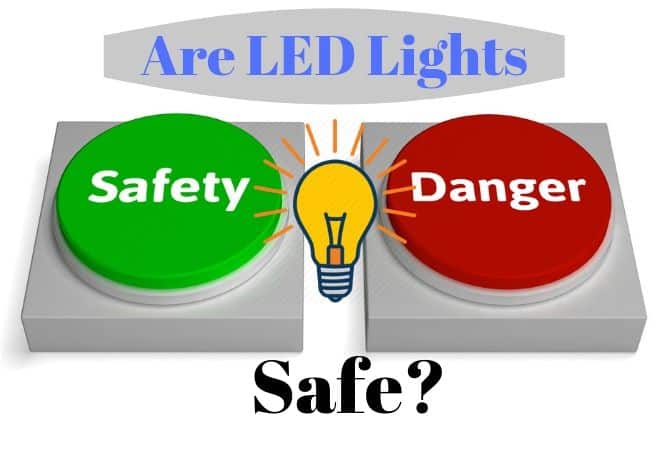Last Updated on April 2, 2020 by The Tutor
Are LED Lights Safe?
 LED is an acronym for ‘light-emitting diode’. It is a semi-conducting source of energy that lights up when currents flow through it. They are very popular on the market today because they are extremely energy efficient and use up to 90% less power than incandescent bulbs. As with any light source, there are both advantages and disadvantages to using them, which begs the question, “Are LED lights safe”?
LED is an acronym for ‘light-emitting diode’. It is a semi-conducting source of energy that lights up when currents flow through it. They are very popular on the market today because they are extremely energy efficient and use up to 90% less power than incandescent bulbs. As with any light source, there are both advantages and disadvantages to using them, which begs the question, “Are LED lights safe”?
Are LED light safe? LED lights are generally considered to be safe overall. However, some studies have shown potential health risks associated with one type in particular – the cool-white or blue LED light.
How do LED Lights Work?
LED lights work with the help of a semi-conductor that emits light when a current runs through it. Electrons in this  semiconductor recombine with the electron holes inside the bulb, releasing energy in the form of photons, turning it into light.
semiconductor recombine with the electron holes inside the bulb, releasing energy in the form of photons, turning it into light.
How is an LED Light Different from a Regular Bulb?
LED lights are brighter than incandescent or halogen lights. Unlike halogen bulbs, LED’s are not available in high wattages. LED’s use approximately five times less power than incandescent bulbs while still producing the same amount of light!
Advantages of LED Lights
LED’s are used for so many things nowadays, from Christmas tree lights to motor vehicle headlights. They are small, durable and long lasting. Let’s take a look at the top-ten advantages of LED lighting in more detail below:
- Energy efficient. These little wonder lights are great for conserving energy and use five times less than other types of bulbs. They are capable of outputting 135 lumens per watt!
- Long lasting. LED lights last much longer than traditional incandescent lights. A good quality LED light should last up to 50,000 hours (or even more)!
- Often referred to as ‘solid state lighting’, LED lights are made with strong materials. They do not have a tube, which can easily be broken.
- No warm-up period required. LED’s light-up instantly! It take only nanoseconds for it to illuminate.
- Not susceptible to cold temperatures. LED lights are not affected by cold weather and actually work better in lower temperatures. They will work even in sub-zero degrees!
- Easily directed. You can direct the light from LED’s so it will illuminate the exact area you want it to. Thus, no light is ‘wasted’.
- Colors stay truer, longer. LED’s keep their vibrancy, unlike fluorescents. They are the perfect choice to highlight work displays or to draw attention to retail services because they are brighter than other bulbs.
- Environmentally friendly. LED lights do not contain harmful substances, such as mercury. Therefore, they are considered safe for the environment. Also, because they use less energy, they reduce the need for power plants while at the same time decreasing greenhouse gas emissions.
- Easily adjustable. LED’s can be ‘controlled’. The color and brightness levels can be easily increased and/or decreased.
- Overall affordability. While the upfront cost of an LED light is generally higher than that of an incandescent light, it saves money in the long run by using less energy and requiring less change-outs.
Disadvantages of LED Lights
Just as there are many advantages to LED lighting, so too are there disadvantages. Let’s explore these in more detail below:
- Potential eye damage. There is some concern that cool-white LED’s can potentially exceed the safe limits of UV light, also known as the ‘blue light hazard’. This can result in possible damage to the retina of the human eye, if over-exposed occurs.
- Affected light quality. Objects under cool-white LED illumination can often appear differently than those under incandescent light, or even sunlight. That being said, top-of-the-line LED’s have now reached a state-of-the-art level, making them superior to the traditional incandescent light in color rendering.
- Temperature dependence. LED lights are directly affected by the ambient temperature in their environment. Higher temperatures could negatively affect their performance level. LED’s must have adequate heat-sinking in order to maintain their effectiveness. This is especially important when medical, military or automotive applications are involved.
- Possible blue light pollution. Though free of hazardous substances (such as mercury), LED’s (especially the cool-whites) emit more harmful UV or blue light than traditional outdoor light sources. Therefore, they can potentially cause increased light pollution.
- Voltage sensitivity. LED lights require a specific voltage level. Anything over and above this level will result in poor lighting performance.
- Greater upfront cost. LED lights are more expensive to purchase than incandescent lights. The higher price is usually based on the low lumen output as well as the specific circuitry and power supplies necessary to engineer.
What are the Side Effects of LED Lights?
Using LED lights could have potential side effects. Prolonged exposure has been linked to increased eye irritation, such as redness and itching. Life-long exposure has the potential to cause irreparable damage to the retina, such as cataracts. The reason behind LED’s risk to eyes involves the amount of UV (or blue) light emitted.
Mild headaches have also been reported from over exposure to LED lighting. The most common complaint with LED lights is the burn risk associated with handling them. These lights can get hot, though not as hot as incandescent bulbs (which can reach an external temperature twice that of LED’s). They should always be handled by the diffuser, never the heat sink.
Are LED Lights Safe for Reading?
The answer to the question, “Are LED lights safe for reading?” is yes! A soft, warm LED light is good for reading. However, try to avoid the cool-white ones, as they emit more UV (or blue) light which can bother (and even damage) your eyes after an extended period of time.
Can LED Lights Cause a Fire?
The answer to the question, “Can LED lights cause a fire?” is NO. It is highly unlikely that an LED light would ever overheat and catch fire. LED’s maintain a relatively low temperature in comparison to other lights, such as halogen or incandescent bulbs. The heat they do produce is held internally (as opposed to being emitted externally). As well, LED’s tend to have a much lower wattage then other bulbs. It is the high watt bulbs that pose the serious fire risks.
Are Led Lights Safe to Leave On?
For the reasons mentioned above, LED lights are considered safe to leave on for extended periods. However, the transformer often connected to the lights (think Christmas tree) is why you should turn off LED lights before you go to sleep. The transformer has the potential to overheat and thus poses a fire risk. To avoid this, turn off your LED lights at night to allow the transformer to cool down.
Are LED Lights Safe for Babies?
As most parents know, babies like to look at lights. They are attracted to the colors and the brightness. It is okay for babies to look at LED-lighted images. However, just be sure they are illuminated by the warmer, softer bulbs as posed to the cool-white ones, which pose a potential ‘blue light hazard’, as discussed earlier in this article.
Are LED Lights Toxic?
Studies show that although LED and CFL bulbs may have a higher toxic hazard potential versus incandescent bulbs, they are still considered to be relatively safe. The concerns are related to metals such as aluminum, zinc, and copper. The LED studies are not conclusive as to whether the toxins are harmful to humans while being used in the home, or afterwards when they end up in a land fill.
What are LED Lights Used For?
LED’s are considered the future of lighting! They have a variety of uses and almost limitless options. Let’s take a look at some of these uses/options below:
- Entertainment Events. LED lights are great for illuminating all types of indoor (and outdoor) signage such as exhibits, displays and billboards. They are energy-efficient, long-lasting, and color-true.
- Homes. According to Home Depot, the average LED light, if left on for approximately three hours per day, will last twenty-two years! This statistic alone makes it the ideal choice for many household needs such as lamps, track lighting, ceiling lights, and outdoor spotlights. Christmas tree light strands are also made with LED bulbs.
- Offices/businesses. Office and businesses alike will often use LED lights. They illuminate general work areas as well as meeting and storage rooms. These lights are usually installed in the ceilings. Outside the office/business, LED’s are used to light up entrances, lobbies and corridors.
- Headlights, tailgate lights, fog lights and daytime running lights for vehicles will often be made using LED’s.
- Art Work. LED’s can be used to enhance pieces of art of even incorporated into the artwork itself! Ceiling-mounted accent lights, track lights and wall washers are just a few examples.
Conclusion
LED lights are a safe, energy-efficient lighting source. They are long-lasting and good for the environment. They have a variety of uses, from home to office, indoor to outdoor. The biggest risk with LED lights comes from the cool-white bulbs that emit higher levels of UV or blue light, which (with prolonged exposure) can irritate and potentially damage the human eye.
The pros of LED’s indeed outweigh the cons. These top-of-the-line, state-of-the-art bulbs are truly the future of lighting The uses and options for these little lights wonders are almost limitless. So, feel free use LED’s to brighten and illuminate your surroundings whenever possible. After all, it is best to “Live in rooms full of light” – Cornelius Celsus.
Please check out my recommended LED light bulbs page to pick out the right lighting for your needs.
